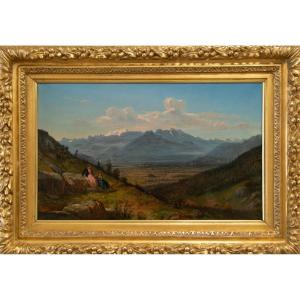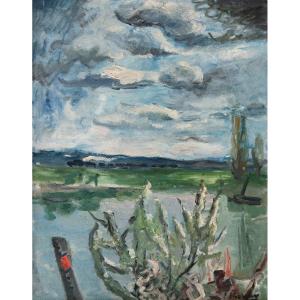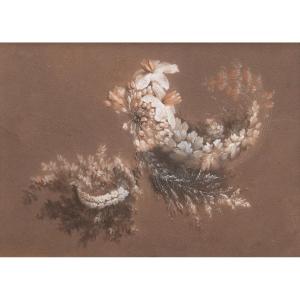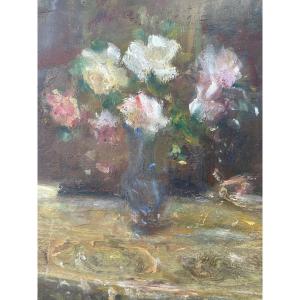In this work, he shows a bouquet of flowers in a vase. Lilacs, daisies and smaller white flowers are presented in colours and textures that reflect his meticulous observation of nature. The subtle nuances of the petals, a mixture of white, pink and violet, evoke an atmosphere of freshness and fragility. The artist has chosen a centred composition, in which the vase acts as a visual anchor, while the flowers are scattered all around.
The artist used a variety of brushstrokes to create distinct textures. The petals of the flowers are painted delicately, conveying their finesse, while the leaves are rendered with broader, more spontaneous strokes, giving them a more lively appearance. The brilliance of the vase is well rendered thanks to a subtle play of reflections. His style is influenced by his master François Vernay and Impressionist painters such as Auguste Renoir.
The background is deliberately left dark and indistinct, a classic feature of still lifes. This choice allows us to focus on the main elements (flowers and vase) while creating a timeless, intimate atmosphere.
The signature at top right, ‘J. Martin’, is highlighted in bright red, contrasting with the rest of the work.
From 1881 onwards, Jacques Martin took part in numerous Lyon and Paris salons, and was one of the artists whose work was selected for the Universal Exhibition of 1894 and the International Exhibition of Fine Arts in 1914.
In 1904, together with the painter Eugène Brouillard, he founded the Salon d'Automne de Lyon.He also exhibited at the Galeries Pouillé-Lecoultre, Maire-Pourceaux, Malaval and the Galerie des Archers.
Jacques Martin also made a name for himself as a violinist, founding a chamber music society where he performed classical music by Johann Sebastian Bach, Ludwig van Beethoven and Georg Friedrich Haendel.

































 Le Magazine de PROANTIC
Le Magazine de PROANTIC TRÉSORS Magazine
TRÉSORS Magazine Rivista Artiquariato
Rivista Artiquariato